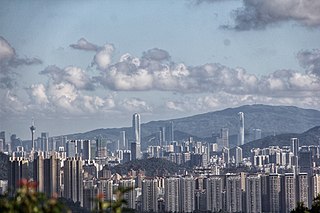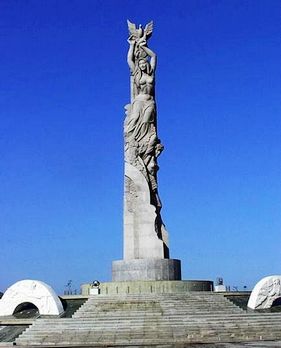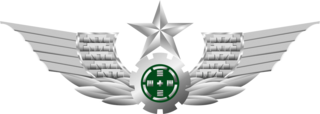
Zhuhai is a prefecture-level city located on the west bank of the Pearl River estuary on the central coast of southern Guangdong province, People's Republic of China, on the southeastern edge of the Pearl River Delta. Its name literally means "pearl sea", which originates from the city's location at the mouth of the Pearl River meeting the South China Sea. Zhuhai borders Jiangmen to the west, Zhongshan to the north and Macau to the southeast, and shares maritime boundaries with Shenzhen and Hong Kong to the northeast across the estuary.

Sun Yat-sen University is a public research university in Guangzhou, Guangdong, China. It is affiliated with the Ministry of Education, and co-funded by the Ministry of Education, SASTIND, and Guangdong Provincial Government. The university is part of Project 211, Project 985, and the Double First-Class Construction.

Pan Yuliang, born as Chen Xiuqing, also known as Zhang Yuliang (張玉良), is remembered as the first woman in China to paint in the Western style. She studied in Shanghai and Paris, and taught at the École des Beaux Arts. In 1985, much of her work was transported to China, and collected by the National Art Museum in Beijing and the Anhui Museum in Hefei. Despite being remembered for introducing Western paintings to China, she also provided a new lens to how women were seen through her paintings, not just as objects but as subjects. She won several awards for her work and exhibited internationally in Europe, the United States, and Japan. Significant paintings, sculptures, and prints by her are still conserved in France in the collection of the Cernuschi museum. Her life as an artist has been portrayed in novels, films, and operas in China and the United States. Her art evolved within the flux of conflicting dichotomies of East and West, tradition and modernity, male chauvinism and emerging feminism. Pan is also remembered as an artist who engaged with labels, such as "contemporary/modern," "Chinese," and "woman" artist, while also questioning them.

Zhuhai Jinwan Airport, also called Zhuhai Sanzao Airport before 10 January 2013, is the airport serving the city of Zhuhai in South Central China’s Guangdong province. It is located some 50 kilometres (31 mi) southwest of the Zhuhai city center in Sanzao Town, Jinwan District, and 25 kilometres (16 mi) southwest of the special administrative region of Macau.

The Guangzhou Academy of Fine Arts is a Chinese national university based in Guangzhou which provides doctoral, master and bachelor's degrees in fine arts and design.It is the only fine arts institution of higher learning in Guangdong Province and even in South China, and one of the eight major fine arts academies in China, with 12 colleges and one affiliated secondary fine arts school, and the existing Changgang campus, University Town campus and Foshan campus, with nearly 10,000 students of all kinds.

Guangzhou–Zhuhai intercity railway or Guangzhu intercity railway is a dedicated, grade-separated regional railway linking Guangzhou South railway station in Panyu, Guangzhou, Jiangmen railway station in Xinhui, Jiangmen, and Zhuhai Jinwan Airport in Zhuhai, via Shunde, Zhongshan and Jiangmen, in Guangdong province. It is the first line completed in the Pearl River Delta Metropolitan Region intercity railway network. It is operated by China Railway Guangzhou Group.

Qi'ao Island is an island of Zhuhai, Guangdong province, China.
Pan Ximing is a Chinese footballer who currently plays for China League One side Liaoning Tieren.

Changchun World Sculpture Park is located in Changchun, Jilin, China. It is a collection of Eastern and Western art and sculpture set in a natural landscape and run as a theme park. It was named a national 5A-class tourist attraction.
Rong Baisheng was a Chinese architect and civil engineer. A pioneer in skyscraper design and construction in China, he was elected an academician of the Chinese Academy of Engineering in 1995. His works include the Guangdong International Building, which was China's tallest building when completed in 1990, and the Shenzhen Shangri-La Hotel (1981).

Southern Theater Command Ground Force is the Chinese ground force under the Southern Theater Command. Its headquarters is in Nanning, Guangxi. The current commander is Zhang Jian and the current political commissar is Wang Donghai.

Guo Yuanqiang is a Chinese politician who is the current party secretary of Wuhan, in office since September 2021. He is a representative of the 19th National Congress of the Chinese Communist Party and was a member of the 12th National Committee of the Chinese People's Political Consultative Conference.

Yang Yuyu was born Yang Ying-feng in Yilan, also known by his nickname Yu-yu (呦呦), was a Taiwanese sculptor. He was renowned for his late-period modernist abstract composite forms, stainless steel material, and Chinese aesthetics.
Shi Guo is a Chinese artist known for his experimental Chinese ink painting. He is the son of Chinese traditional painting artist Shi Lu.

Zhuhai Fisher Girl is a statue and landmark in the Xianglu Bay area of Zhuhai, Guangdong, China. Commissioned ahead of the establishment of the Zhuhai Special Economic Zone, the statue was designed by Pan He based on a local legend about a celestial being who descended to the region to live as a simple fisherwoman. Though its cost was controversial, the statue was completed in 1982 and became part of the region's growing tourism industry. The statue was designated a cultural relic in 2014, and the following year the sculptor completed a companion piece with his son that depicts the fisher girl as a mother. A proposal has been made to expand the area around the statue into a mixed-purpose recreational area.

Yang Pao'an was a Chinese Marxist and early member of the Chinese Communist Party (CCP). Born in Xiangshan County, Guangdong, he promoted the spread of Marxism in southern China through newspaper publications and involvement with the May Fourth Movement and the Canton–Hong Kong strike. With his friend Tan Pingshan, he was one of the CCP's envoys to the Kuomintang (KMT) during the parties' First United Front and held several roles within that party. Elected to the CCP's Central Supervisory Committee in 1927, he was dismissed later that year due to his association with Tan. Yang remained active with the party, working on its newspaper publications through the end of his life. In August 1931, he was detained in Shanghai by the KMT and executed.

Huang Shaoqiang was a Chinese artist of the Lingnan School. The grandson of a village official, he learned poetry, calligraphy, and art from a young age. He studied at the Bowen Art School and was a pupil of Gao Qifeng and Gao Jianfu, who taught a blend of Western and Chinese painting. After graduating, he became an educator while developing his own career as an artist, holding his first solo exhibition in 1926. Following the Japanese invasion of Manchuria, Huang raised funds for the war effort. He travelled China for several years, settling in Guangzhou by 1935. As Japanese forces moved southward, he fled to Hong Kong briefly before ultimately returning to his hometown in Guangdong. Sickly, he died at his ancestral home.

He Jianshi was a Chinese cartoonist, painter, and songwriter. The son of He Kunshan, a wealthy businessman, He learned the arts in his youth, as well as swordfighting from a monk in Sichuan. In 1905, He began producing cartoons for the Journal of Current Pictorial, using among numerous others the pen name Jianshi ("Swordsman"), and continued producing manhua for The True Record when that magazine was established in 1911. A member of the Tongmenghui, an anti-Qing movement, he promoted the use of Chinese opera to spread revolutionary ideas. Analysis of He's work has emphasized his flamboyant style, drawing from the literati tradition while blending realism and exaggeration.

On 11 November 2024, a man drove his SUV into people on the exercise track at the Zhuhai Stadium sports center in Zhuhai, Guangdong, China, killing 35 and injuring 43 more. The driver then attempted to commit suicide by cutting himself with a knife; he was taken into custody and sent to a hospital. The man is believed to have been motivated by anger over a recent divorce settlement. On 27 December, he was sentenced to death and executed on 20 January 2025.
Chen Hsia-yu was a Taiwanese sculptor. He was born in Longjing Village, Dajia County, Taichū Prefecture. He studied sculpture under Kooyu Fujii, who encouraged him to participate in the Shin Bunten, where he was selected for three consecutive years and obtained the "no inspection" qualification. He was a founding member of the Taiyang Art Association Sculpture Department, a Provincial Art Exhibition judge, and a teacher at Taichung Normal School. He later withdrew from the association and resigned from his teaching position and judgeship. He continued to create until he was over 80 years old. He died of heart failure in 2000 at the age of 82.


















